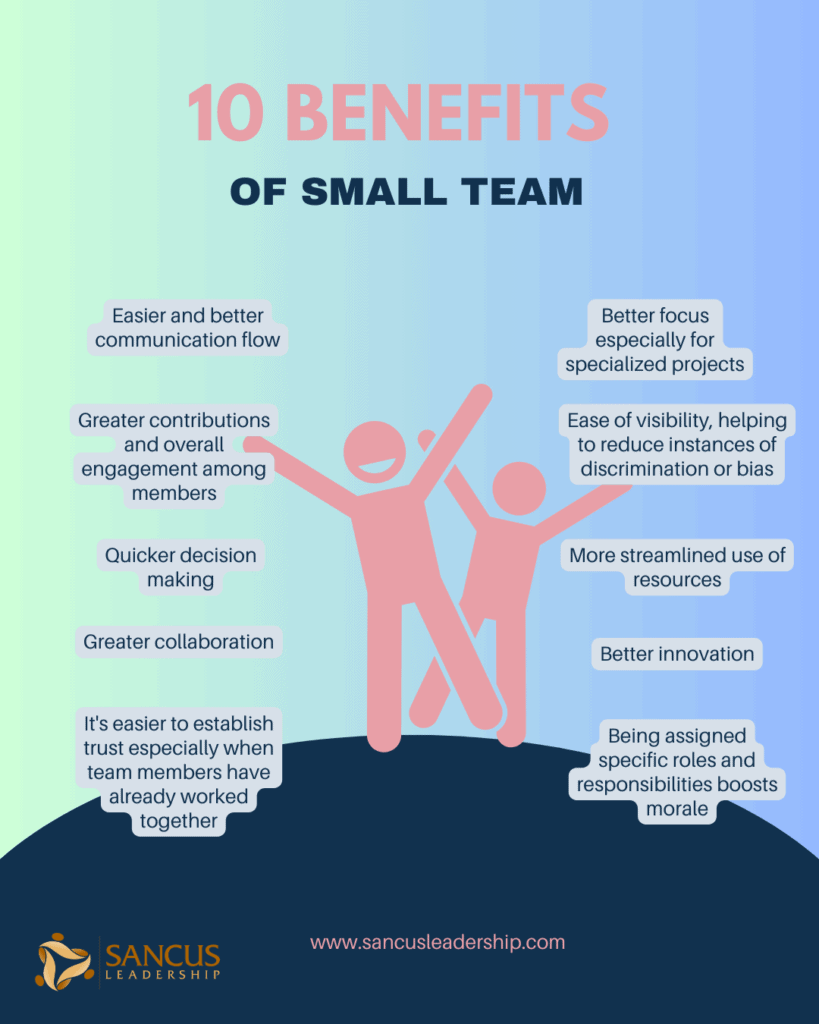Multiple factors determine a team’s success, and size can be one of the most important. Effective teamwork (especially on small teams) can increase business sales by 27% and improve customer satisfaction by 41%. With good cooperation, employees are often motivated to achieve team goals and put in extra effort.
A small team is a group of two to ten people working collectively on a specific task. Managers usually determine a team’s size based on project requirements. Provided team members have the requisite skills, and small teams are more efficient than their larger counterparts.
There are also many other benefits of using small teams in the workplace. Read on to learn what they are and learn more about the small team concept.
What Is a Small Team Concept?

More than half of US professionals believe teamwork is essential to success. Companies know the value of having employees work in teams, with managers often using a small team for better efficiency and effectiveness.
The small team concept manages at most ten people to achieve a specific goal. This team size usually results in better flexibility, greater accountability, and increased autonomy. Well-managed small teams tend to achieve better results than larger teams.
Small teams can be permanent or temporary. They can include people in the same department, be cross-functional, or be self-managed. Virtual teams are also growing in popularity and have become necessary with the increased number of remote employees.
How Do Small Teams Work?

The main tasks of a small team are similar to those of a larger one. However, there’s a need for even more focus and teamwork since fewer people exist.
High Level of Autonomy of The Team
The main goal of a team may be to create a new product or improve a current process. Every task a team member performs must be relevant to attaining this. Each team member must know this. They also need to know what role they play in achieving this goal.
Small teams are faster at intra-team communication and understand each individual of the team more deeply. This allows the team also more accurately to understand the organization and its need; a properly set up small team will, therefore, be much more able to work with less supervision from management.
A properly set up small team will, therefore, be much more able to work with less supervision from management.
In my EOD unit (military bomb disposal), we were a team of six people with a high degree of autonomy; we rarely had much interaction with our platoon commander other than with logistical support. Instead, we would get tasked, plan, execute, and report once the mission was done.
High Level of Autonomy of The Individual
Managers will select team members based on skills and expertise (hopefully), amongst other factors. This allows each member to complete individual tasks and build on their capabilities, which helps bring the team closer to achieving the main goal or objective. Breaking down tasks and assigning them to different team members increases efficiency and productivity.
The benefit of the small team is for its team leader to understand each individual, their limitations, and their passions. This information allows the individual to be tasked with things they are sufficiently competent and interested in so that they can work nearly autonomously.
High Level of Creativity
Each team member needs to use their expertise to help the team achieve the ultimate objective. This involves formulating ideas, analyzing their feasibility, and deciding which idea works best. Discipline and proper management are crucial to stay on track while doing this.
In a small team, there is a higher probability that each member feels more psychologically safe and, therefore, willing to share their ideas. Suppose the team leader can cultivate the production of ideas by not being condescending while hearing all the bad ones. In that case, there is a high probability that one game-changing concept will appear sooner or later.
In a small team, there is a higher probability that each member feels more psychologically safe.
High Level of Intra-team Support
An individual’s expertise will determine how they can support other team members. They may need to impart knowledge or guide a specific process. This often provides a better understanding of how one task may affect another and can also impact the project’s outcome.
If you want to support someone proactively (i.e., solving a problem they didn’t know they had), you must understand what their responsibilities and roles are; in a small team, this is easier since there are fewer team members, allowing for more time to understand each person’s needs.
High Level of Intimacy
Leading a small team requires a balance of guiding without micromanaging. Managers should know team members’ capabilities and when to step in to help eliminate roadblocks. They may also need to make decisions that may change the team’s strategy or goal.
To get the most out of any system, including a system made of humans, we must understand its components, what makes it work better, and under which circumstances it will stop. As a small team leader, you have the excellent opportunity to understand every piece of your machinery with incredible detail, Something that can’t be done on a large team.
My most valuable lesson learned is that if you take care of your people and really try to understand them as human beings, then you are bound to make amazing friendships and build a top-performing team in the organization.
Then you are bound to make amazing friendships and build a top-performing team in the organization.
| Key Points | Description |
| High Level of Autonomy (Team) | Small teams have a clear and specific goal, and every team member understands their role in achieving that goal. Intra-team communication is faster and more accurate, allowing for less supervision from management. |
| High Level of Autonomy (Individual) | Each team member has a specific set of skills and expertise, allowing for the breakdown of tasks and increased efficiency. The team leader understands each individual’s strengths and limitations, allowing for tasks to be assigned autonomously. |
| High Level of Creativity | Each team member uses their expertise to formulate ideas and decide which idea works best. In small teams, there is a higher probability of psychological safety, allowing for more idea-sharing. |
| High Level of Intra-team Support | An individual’s expertise will determine how they can support other team members. They may need to impart knowledge or guide a specific process. In a small team, this is easier since there are fewer team members, allowing for more time to understand each person’s needs. |
| High Level of Intimacy | Small team leaders have a clear understanding of each team member’s capabilities and know when to step in to eliminate roadblocks. They also make decisions that may change the team’s strategy or goal. Small teams allow for a more detailed understanding of each team member’s role and contribution to the team’s success. |
Does Team Size Matter?

There are several components a team needs regardless of its size. These include:
- A defined goal, specific task, or project to achieve.
- Diverse skills among members.
- Assigned responsibilities to each member.
- Efficient operating systems to provide support.
- Healthy interaction and exchange among members.
- Accountability from each member.
- Good external relations.
However, these components are usually easier to manage when a team is small.
During any team experiences opposing views from people with different personalities that can result in conflict, managers spend more time and energy dealing with this problem in larger teams than in smaller teams.
The higher number of different ideas and beliefs may make decision-making more challenging in a larger team. Conversely, managers may also have to guard against groupthink. All these elements can adversely affect productivity and impact timelines.
Although possible, these problems are less likely to occur in smaller teams. There are also many other benefits of working with a small team.
Here are 15 indicators that your team size is way off!
Benefits of Small Teams

Can you feed your team with two pizzas? If you can, then your team is the ideal size for an effective team, according to Jeff Bezos. This team size is typically between five to eight members and is usually more efficient.
Here are some other benefits of small teams:
- Easier and better communication flow
- Better focus especially for specialized projects
- Greater contributions and overall engagement among members
- Ease of visibility, helping to reduce instances of discrimination or bias
- Being assigned specific roles and responsibilities boosts morale
- More streamlined use of resources
- Greater collaboration
- It’s easier to establish trust especially when team members have already worked together
- Better innovation
- Quicker decision making

Small teams are more conducive to increased productivity. They’re also easier to manage as you can learn members’ skills and capabilities faster. This helps to ensure the appropriate assignment of tasks. It’s also easier to monitor group developments and be more accessible to members.
Ways To Build an Effective Team

Bringing all these elements together can help you create an effective team. However, management is a key component of a team’s success. Here’s what you can do to lead your team effectively:
- Practice a leadership style that promotes open communication and builds trust.
- Set clear objectives for the team.
- Communicate regularly and effectively.
- Assign work fairly and based on member skills and talents.
- Manage conflict and encourage collaboration.
It’s important to recognize milestones achieved by the team. You should also reward members after they complete the team assignment. This will encourage greater willingness if there is a need for them to work on teams in the future.
It’s important to recognize milestones achieved by the team. You should also reward members after they complete the team assignment. This will encourage greater willingness if there is a need for them to work on teams in the future.
Todd Adkins, Director of LifeWay Leadership, discusses in this short video how communication on large teams quickly becomes complex and why it is better to have small teams.
Final Thoughts
Many companies are learning the value of collaboration and teamwork. They’re even adopting technology to facilitate this as employees work remotely. Teamwork not only benefits employees but also increases profitability and customer satisfaction.
Smaller teams are proving to be more effective in achieving this. However, there must be clear objectives that each member is aware of. Open communication should also continue throughout the project until completion.



